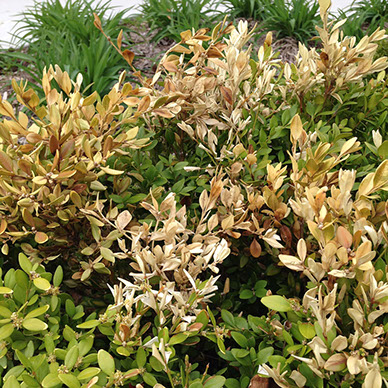The science of preserving nature since 1964
Winter Protection for your Evergreens
During winter, your evergreens are the showcase of your landscape. However, winter can also be very stressful for them. The cold, winter wind, and extreme fluctuations in temperatures can result in moisture-loss, leading to dieback (the progressive death of twigs and branches which generally starts at the tips). Without winter protection, even if evergreens appear green in winter, they could turn brown by spring as it gets warmer.
If there are evergreen trees and shrubs on your property, have them assessed for an anti-desiccant treatment (winter protection) as soon as possible. It involves applying a mild substance that forms a thin, transparent film on and under leaf surfaces (mimicking one of the trees’ natural defenses). This film acts as a moisture barrier, dramatically slowing the outward movement of water from a tree’s foliage.
Additionally, anti-desiccants help minimize sunscald, which is a condition resulting from white surfaces (anything covered in snow) reflecting sunlight onto, and ultimately burning, the foliage of the tree or shrub. Signs of sunscald include golden or brown needles as well as foliage that has developed an overall yellowish or off-green color. Leaves may appear bleached. The damage commonly occurs on the south or southwest side of the plant or on the windward side of a plant that is exposed when temperatures warm in early spring.
Trees and shrubs must be completely dormant when anti-desiccant is applied so November and December are usually the best months for this treatment.
Newly planted material is especially prone to desiccation as they have not yet been established in the landscape and could lose almost 70% of their root system when being dug.
Common trees and shrubs susceptible to desiccation in our area include:
- Boxwood
- Holly
- Hemlocks
- Rhododendrons
- Evergreen Azaleas
- Andromeda
- Laurel; esp. Schip
- Arborvitae
- Leland Cypress
- Ilex


Boxwood shrubs (above) and Holly (below) that are suffering dieback as a result of desiccation during winter.


LOCATIONS:
Lower Westchester County, NY and New York City
58 Beechwood Ave, New Rochelle, NY 10801
914-576-0193
Upper Westchester (North of I-287)
15 Broadway, Hawthorne, NY 10532
914-741-1510
Fairfield County, Connecticut
547 Hope Street, Stamford CT 06907
203-348-4111
Bergen & Passaic Counties, NJ
504 High Mountain Road, North Haledon, NJ 07508
973-636-6711
Contact us for a Free Consultation
